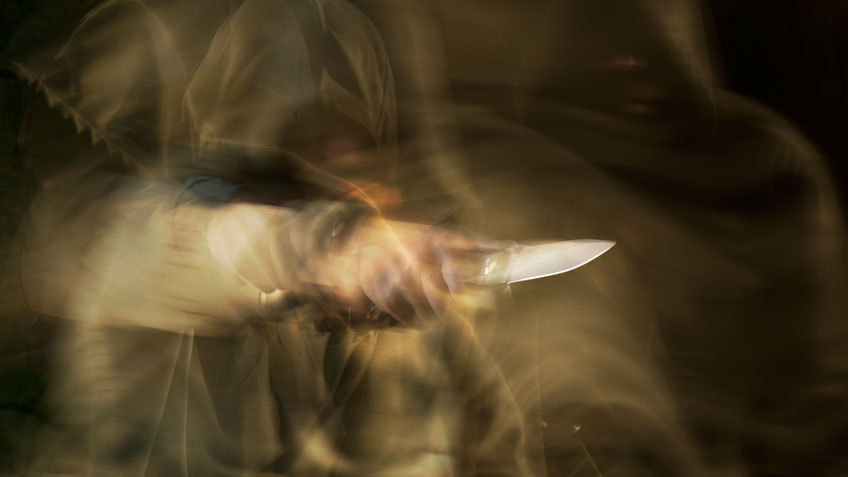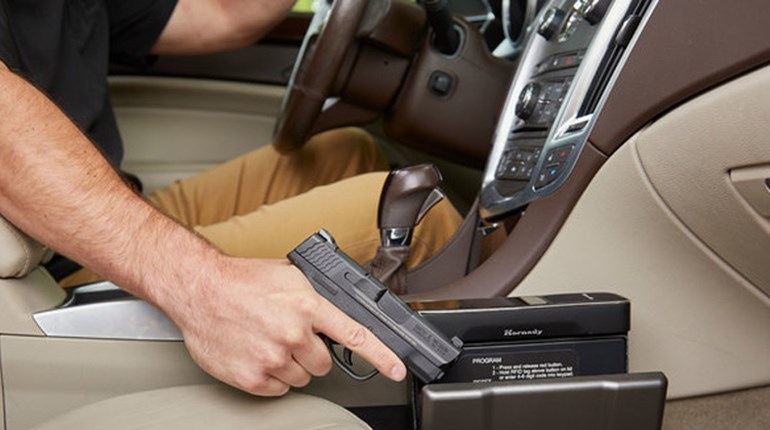
In the past several months, curbside stabbings in Jerusalem, slashings in New York and an edged-weapon assault injuring eight at a shopping mall in Minnesota are clear examples of a disturbing trend of knife attacks against civilians. Although we may all be potential victims of physical violence, few of us are fully equipped to handle such assaults.
Being prepared for a knife attack is 50 percent physical and 50 percent psychological. Most human beings fear the unknown, and that is especially true of a knife attack. Because we are unfamiliar with the mechanics of a knife attack, it makes us feel uncomfortable and squeamish. It’s up-close. It’s personal. And it could potentially end in loss of blood, limb or life.
“Either you control the threat, or the threat controls you.”
How can you control a threat? You control a threat by either avoiding it altogether, mitigating its impact or defending against it. Failing avoidance or mitigation, you are afforded only three defensive options in any knife attack, and they are:
Take flight—get away quickly as you can.
Fight—do what it takes to stop the threat or allow you to get away.
Freeze in place—surrender to your attackers.
Flight, fight or freeze.
There are no other options.
Scale of Injury
If you’re caught in a knife attack, it is imperative to keep bodily harm, and harm to those with you, to a minimum. As with any physical altercation, wounds play a significant factor in your ability to prevail, and to minimize your personal injury it’s critical to understand this at a deeper level.
In any violent physical altercation, there exists the potential for five levels of injury referred to as the Scale of Injury. At the lowest end of the scale is no injury, which, is of course, the most desirable outcome in any scrape (Level 0). The next level up from no injury is a minor injury such as scratches, cuts or abrasions (Level 1); these are uncomfortable but still better than the next level up on the scale, which is a recoverable injury (Level 2) such as a broken leg, broken arm, broken nose and the like. Up one more rung on the scale (Level 3) is a permanent injury, which would include such horrific results as blindness, paralysis or loss of limb. The last and final step in the Scale of Injury is (Level 4), a fatal injury causing death. Your goal in managing any knife attack is to keep your injuries as low on the scale as possible. Anything greater than Level 1 on the Scale of Injury renders you combat ineffective and turns you into a detriment to yourself and those with you.

Reaction Time
“Hey, I’ve got my gun, I’ll just shoot him!” Sure, if you’re already in condition yellow, aware that you are the target of an attack, can see your assailant, identify him/her/them as a threat, make the decision to shoot or not to shoot, draw your gun from concealment (cognizant of your backstop), deliver precise and multiple combat-effective round placement, all in 1.5 seconds or less, then yes, you can “just shoot him.”
However, the sobering reality is that a conditioned, military-age male between the ages of 18 and 32 at full stride can close the distance of approximately 7 to 10 yards in less than 2 seconds. Assuming you are assaulted by a single attacker with a knife and given that the average Unit of Human Reaction Time is .25 seconds, the math can be found in the included matrix.
Let’s further assume your assailant positively reacts to your round placement. The total amount of response time (if performed flawlessly and under duress per the above conservative timetable) comes out to 4.0 seconds, versus 2.0 for the actual knife attack. Yes, that’s twice the time. Even if by some miracle you can pull it off, what about those of us mere mortals who don’t train for six hours a week and somehow fail to perform flawlessly in the face of imminent danger?
Any non-ballistic weapon, such as a knife, requires close-distance contact to be effective in raising your Scale of Injury. The relationship between distance and Scale of Injury is similar to the relationship between distance and reaction time. The less the space between you and the threat, the less time you have to react. Conversely, the greater the space, the greater the amount of reaction time. This concept is known as the Reactionary Gap.
Time is a critical factor. The longer you stand toe-to-toe in front of a spinning lawn-mower blade, the greater your chances of incurring injury and falling further behind the action/reaction power curve. The quicker you take control of the situation, the greater your odds are of keeping control, getting to your gun (if you have one) and gaining the initiative to move yourself and those with you to safety.

 Controlling the Threat
Controlling the Threat
To gain control of a “knife fight” you must gain control of your immediate environment. To do this you must first control your time and space. We know from the Reactionary Gap, the more space you have, the more time you have to react, and the less space there is to work with, the less time you have to react. More time and more space afford you more options and greater opportunities (to include presenting a firearm). Less time and less space relegates you to fewer options and less opportunity to solve the problem.
You gain control over your opponent(s) by securing for yourself the most options and greatest number of opportunities. You accomplish this task by gaining more time and more space. But exactly how can you do that?
By assuming control of the physical components paramount to your defense against any knife attack: distance, position and movement.
Exit or Equalize
The very best defensive option against any knife attack is distance. The old adage “distance is your friend” is your first and best defense. By immediately moving away from the threat, you have increased space, which buys you time, which affords you more options to solve the problem. However, it’s not always possible to put space between yourself and the threat. Your next best bet is to place objects between yourself and the threat. Obstructions such as cars, trees, trash cans, your ex-wife’s attorney, furniture, mailbox, etc. force your attacker(s) to move around them, which, in turn, buys you more time to make more distance. More time and more space buy you more options, including getting to your gun.
Creating more space, including using obstructions to buy you more time, works great in open spaces such a parking garages, open outdoor plazas, in a mall, etc. However, these options may not be available to you in certain situations. Engaging a threat in confined areas such as crowded restaurants, hallways, stairways, elevators, etc., presents a problem when creating space (or using obstructions) is not an option. The second component of controlling any fight is position. Failing creation of distance (to include using obstructions), you have the option of changing your physical position relative to your threat.

Imagine you’re standing directly in front of your opponent with a knife in his hand at conversational distance. We call this “Position Zero,” which is not a very good place to be because you’re already at contact range and he’s got a knife in one hand—he can punch or grab you with his other hand, deliver elbows, knees, round-kicks and a head butt, all without the need to move his feet. Most law enforcement professionals are taught to move to “Position One,” which, although still at contact range, is to align your belt buckle with his left arm. A more advantageous position, because it negates the reach of his right arm and right leg, position one is the standard for conducting field interviews.
Moving forward, standing directly next to your attacker facing his left shoulder is labeled “Position Two” as this places you in an even more advantageous position. Ultimately, the dominant position in any fight is getting to your opponents back or “Position Three,” which places you directly behind your opponent facing the back of his head, exactly opposite of Position Zero. Position Three is the best physical position you can be in any fight.
If you can’t change your distance from the threat or use obstructions, then fight for the higher numbers—that is, place yourself in a position of advantage. These positions are inversely correlated to the Scale of Injury. That is, the lower your physical-position number relative to the threat, the greater your Scale of Injury is likely to become. The higher the position, your Scale of Injury is likely to be lower. Fight for the higher position numbers.
Lastly, stay mobile. A moving target is always more difficult to hit than a stationary target. Someone chasing you with a knife will have a much more difficult time making contact with your body when you’re moving and changing direction.
You are at a horrific disadvantage with your bare hands versus an attacker swinging a knife. Immediately get something in your hands. It can be a book, your backpack, a trash can, a rolled up jacket—anything that can protect you from a sharp blade. Even if you need to smack the knife away with your bare hands, don’t just stand there trying to reach for your holstered gun while getting stuck like a pig. Your end goal is to keep moving until you can either create enough space and time to take flight or gain access to your firearm.
Your Best Bet
Looking at it as a threat progression, the very best knife defense starts with avoidance of the threat altogether. The sooner you can see it, hear it or smell it coming, the sooner you can step off those railroad tracks and avoid that freight train altogether.
Failing that blip on your radar and at less than 10 yards, odds are you’re probably not going to be able to “just shoot him.” Your best bet is to take control of the fight as soon as possible by creating distance or changing your position, using things like obstructions and improvised hand-held weapons of opportunity to create a temporary barrier. And, always stay mobile.
Your best option is to take flight and get out with the lowest Scale of Injury possible, or fight your way to a position of advantage where you can either stop the threat or take flight. If you take away only one concept from this article, remember to exit or equalize and keep your Scale of Injury low.

 About the Author
About the Author
Steve Tarani is a non-ballistic-weapons expert, professional educator, author and keynote speaker. He is a former Central Intelligence Agency employee who served in protective programs and was formerly on staff at the U.S. Dept. of Energy National Security Institute (Security Force Training Department) at Kirtland Air Force Base, where he worked for the U.S. State Department Anti-Terrorist Assistance Program.
Specializing in operational readiness, he is a federally certified force options instructor contracted by the Department of Defense, the National Security Agency, the Federal Bureau of Investigation, the Department of Homeland Security, the Drug Enforcement Administration and throughout the private sector.
Tarani currently works in executive protection and provides professional instruction, and lectures internationally. He is a master knife designer, federal contractor, published author of eight books, author of the IACP Model Policy for carry and usage of knives for peace officers, an active protective agent and remains an advisor to the U.S. Department of Justice, Department of Defense and the International Association of Chiefs of Police.
You can buy his latest book, "PreFense: The 90 Percent Advantage," here.



































